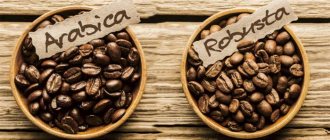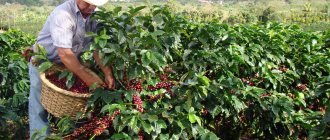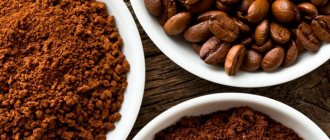30.05.2018
We're willing to bet that you've tried Brazilian coffee at least once in your life, whether you know it or not. Brazil is the world's largest coffee producer: almost a third of all beans grown in the world come from the country, making it also the largest coffee exporter. This fact also affects market conditions in the world: for example, a drought in Brazil can lead to higher prices for goods.
The plantation area in the country covers more than 16 square kilometers. Most of them are located in the southern states of Minas Gerais, São Paulo and Paraná, whose climate is ideal for coffee production.
History of Brazilian coffee
Coffee beans first came to Brazil in the 18th century. The grains brought by the French colonists were from Ethiopia. Plantations began to spread from the north of the country, concentrating on the coasts. During this period in Brazil, the highest priority in the economy was the production of sugar, and coffee was almost a luxury.
By 1820, the country was exporting more coffee than any other product. Since 1840, Brazil has become the dominant player in the industry. This greatly enriched the country and contributed to the formation of a new class of society ruled by the "coffee barons" - wealthy plantation owners.
These "coffee barons" not only wielded economic influence, but also political power, first contributing to the Proclamation of the Republic and later influencing future presidential elections.
During the Coffee Era, Brazil experienced progress as the agrarian elite invested in banking institutions, infrastructure, railroads, and industrialization. Profits from coffee exports were the capital that powered important changes in society, economy, and culture.
While the entire world was becoming dependent on Brazilian coffee, the industry at home was based on the work of slaves: the market was headed for disaster. After slavery was banned in 1888, coffee production almost completely ceased.
A solution to the labor shortage was soon found by the Brazilian government, which began to encourage European immigrants to enter the country to work on the plantations. European workers influenced Brazilian society by accelerating the country's urbanization and expanding the domestic market.
1920 marked the peak of coffee production and sales: Brazil supplied 100% of the world's coffee.
The young Republic grew and developed, but even the most stable and profitable industries and companies could not survive the Great Depression of 1929. Coffee was no exception. Because people couldn't afford coffee, demand plummeted.
The United States was the largest importer of Brazilian coffee, ahead of European countries. During the Great Depression, prices fell, causing huge losses in Brazil. Many believe that the consequences for the country are still being felt.
Changes during the existence of the Republic in the country partly led to the end of the Coffee Era and, at the same time, to the loss of influence of the agrarian oligarchy. The coffee industry has lost its leadership position to other sectors of the economy.
At the same time, it is now clear that coffee has never lost its role as an important product in the Brazilian economy, and the drink is one of the most valuable products in the country. The largest importers of coffee from Brazil are Germany, the USA, Italy, Japan and Belgium.
Domestic coffee consumption
Brazil has made vigorous efforts to increase domestic coffee consumption and has achieved considerable success. The fact that children are given coffee at school from an early age may come as a surprise, but these days coffee consumption in Brazil is on par with the United States. Brazil has a ban on the import of green grains from other countries. Many espresso bars have opened in the largest cities of Brazil, and the prices there are the same as in the best coffee shops in the USA and Europe. These coffee shops have become another symbol of the gap between rich and poor in the country, and it continues to widen.
Geography
Most Brazilian coffee grows in grasslands and non-volcanic soils. The growing altitude varies from 2,000 m to 4,000 m. The country has 14 major coffee regions spread across 7 states. There are approximately 300,000 coffee plantations in 1,950 cities.
With such a diverse geography, coffee from Brazil varies greatly, from traditional to experimental varieties. Farms also differ from each other: these can be small family plantations with an area of less than 10 hectares, or there can be large production units occupying more than 2,000 hectares.
Coffee secrets
The Brazilians themselves are true experts and connoisseurs of this drink. In the morning, according to a tradition recognized throughout the world, they prefer expresso. Throughout the day, residents of this country drink 15-20 servings of coffee in small cups designed for 2-3 sips.
There are a large number of unusual recipes for Brazilian cuisine. The traditional recipe is with dark chocolate or with a beaten egg (for those who like a high head of foam).
Here are a few secrets on how to make coffee the Brazilian way. French press: If you brew the drink for at least five minutes, the result will be an amazingly strong coffee with a chocolate aftertaste. A coffee machine can be found in cafes in any country: the espresso served to visitors always contains Brazilian coffee.
If you can prepare cold brew coffee (in a special device), the drink will be tender and soft, it will perfectly quench your thirst on a hot day. It is better to use not an electric coffee maker, but one that is placed on the stove. And by adding sugar directly to the water, you can get real Brazilian coffee, thick, strong and tart.
Characteristics of Brazilian coffee
Brazilian coffee is soft, nutty, with subtle sourness and a bittersweet chocolate flavor. For this reason, Brazilian coffee is traditionally added to many coffee blends, and is also excellent for making coffee-based drinks. This is also the problem for Brazilian coffee: it is considered more suitable for blends, while stand-alone varieties are perceived by many as less delicious.
In fact, Brazilian coffee is distinguished by its high quality and distinctive notes in taste. The bitterness inherent in varieties from this country sometimes makes people think that the quality of the coffee is low. We advise you to take another sip and experience all the facets of the taste of Brazilian coffee, because it is truly multifaceted. For example, Brazil Santos, with its characteristic spice and cocoa aroma and chocolate-nut flavor, is one such high-quality variety.
Moreover, compared to most coffee countries, Brazil has the most detailed bean classification system. Coffee is graded based on the appearance of the beans, color and cupping results. It is then ranked from best to worst in six grades.
What does this mean for consumers? We have much more information about the variety and can be completely confident in the quality of the coffee we drink.
Most Brazilian coffee is processed using the natural (dry) or semi-washed method. The natural processing method means that the berries are dried after picking without removing the outer shells.
Why is it important? Natural processing is difficult to do without damaging the beans, but it helps create a denser body, sweeter, smoother, and more complex flavor profile. The Brazilian climate, with infrequent rainfall and sunny weather, makes the country most suitable for dry coffee processing. You can read more about the types of coffee processing and their features in our article on this topic.
The old fashioned way, by hand
The first Brazilian coffee plantations appeared three hundred years ago. Whoever they belonged to - both slave owners and colonists from Europe who hired ordinary people. Entire cities grew up around plantations. The export of coffee, which today is grown by concerns and small family enterprises, has long brought the main income to this country. A third of all coffee on the international market comes from Brazil.
Topography, climate, soil composition - this is what distinguishes the taste of coffee grown in different countries, be it Ethiopia or Colombia. Brazilian coffee also has its own characteristics.
This country has almost no mountains - plantations are located mainly on the plains, so the taste of local Arabica is very strong, without a variety of notes. By the way: in Brazil, two main varieties are grown - 80% Arabica and 20% Robusta.
After harvesting, local planters begin drying the grains. The traditional method is simple: soft reddish berries are spread on a flat surface and stirred from time to time. After two weeks, the sun turns the berries into brown, dry fruits. The top crust is peeled, the grains are sorted by size.
This inexpensive processing method is called dry and is done by hand. Modern technology - wet - requires special equipment, is more expensive and expensive, and is almost never used in Brazil.
Coffee culture in Brazil
Statistics show that Brazilians are not at all tired of coffee from their home country. They, unlike residents of other countries, will happily drink strong coffee before bed.
Brazil is not only the largest exporter of coffee worldwide, but also one of its largest consumers. Domestic coffee consumption is constantly growing.
A study conducted by the Brazilian Institute of Geography and Statistics found that coffee is the most popular product consumed on a daily basis by Brazilian citizens over 10 years of age. That's 79.7 liters of coffee per person per year - more than in New York, which is famous for its residents' passion for the drink.
And this is all despite the fact that the coffee sold in Brazil is of the worst quality, because the best varieties are exported! Perhaps this is one of the reasons for low coffee prices in Brazil itself. Cheap and strong is what Brazilians love, and buying expensive coffee seems strange and illogical to them.
People here prefer to drink coffee with added milk, and plain black coffee is not at all popular: many would rather prefer Frappuccino, mocha, raff or coffee drinks with whipped cream.
The country's high-end coffee market exists only in large cities, but even then only through the efforts of major players in the industry who were able to create a new culture in Brazil.
Brazilian coffee has come a long and difficult way, which has allowed it to become a true giant on the world stage. The distinctive taste of Brazilian varieties and a wide geography of growth with a varied and favorable climate have become the main characteristic features not only of coffee from this country, but also determined its history and success. The country’s coffee culture is absolutely amazing, given the scale of the country’s work in the world, but this, rather, is its peculiarity.
Brazil Fine Cup
Soft, sweet taste with chocolate aroma.
440 ₽
(coffee beans, 300 gr.)
Chapada di Minas (region)
Among the coffee growing regions, most of which are in the south, this region stands out for its more northern location. Serious production began here in the late 1970s. The areas where coffee trees grow are small, but the land is flat, and producers are striving for mechanization of labor.
Altitude: 800-1200 meters Harvest: May-September Varieties and varieties: Mundo Novo, Catuaí.
Matas di Minas (region)
The region is located in the Matas de Minas Atlantic Forest with a hilly landscape. Coffee began to be grown in this region a long time ago, and it was Matas di Minas that became rich in coffee and dairy products in 1850-1930. The economy has become more diversified in recent years, but coffee still generates about 80% of agricultural income.
The harvest here is harvested by hand, as the land in the region is hilly with steep slopes. Although the region has many small farmers (almost half of them occupy land plots of less than 10 hectares), the reputation for quality coffee that one might expect from the beans grown here is not. However, the situation is changing for the better, and more and more farms are producing excellent coffee.
Altitude: 500-1200 meters Climate: Warm and humid Harvest: May-September Varieties and varieties: Mundo Novo, Catuaí Flavor profile: Sweet coffee with notes of citrus, caramel or chocolate.
Photo Coffee farm in Cerrado Di Minas. ©CeCafe
Sao Paulo (state)
Sao Paulo is one of the most famous coffee growing states in Brazil. It is also home to the port of Santos, Brazil's main coffee export port.
Main coffee growing regions:
Mogiana (region)
The Mogiana region is named after the Railway, which built the coffee railway in 1883 and thus ensured the rapid transport of beans and the rapid growth of production in the region.
Altitude: 80-1200 meters Average temperature: ≈22°C Harvest: May-September Varieties and varieties: Mundo Novo, Catuaí Flavor profile: coffee is very sweet and balanced.
Centro Oste di Sao Paulo (region)
In this region there are the cities of Marilia, Garza, Orinhos and Avare with small coffee farms, as in Mogiana the area is quite hilly.
Mato Grosso and Mato Grosso Do Sul (region)
This region produces a small portion of Brazil's coffee crop. The vast plateaus are more suitable for grazing and soybean production.
Altitude: 800 meters Harvest: May-September
Coffee harvest map Brazil South America © trabocca.com
Espirito Santo (state)
The state of Espirito Santo ranks third in the country in coffee production, but is also the largest producer of robusta. Its capital is Victoria, a key export port.
Main coffee growing regions:
Montanas do Espirito Santo (region)
This is a highland southern area where more Arabica is grown, so you can find interesting coffee there.
Altitude: 700-1000 meters Harvest: May-September Varieties and varieties: Mundo Novo, Catuaí Flavor profile: coffee with high acidity.
Conilon (region)
Conilon, a Brazilian Robusta, is grown here, usually in small areas and at low altitudes.
Conilon, Brazilian Robusta. ©CeCafe
Bahia (state)
Bahia, a large state located in northeastern Brazil, is the country's northernmost coffee-growing region. Coffee production here only began in the 1970s. However, it has already gained fame due to its quality coffee and the use of new technologies. Approximately 75% of coffee is Arabica. In recent years, more and more interesting coffees have been coming from here, and many took notice when five of the top ten batches at the Cup of Excellence competition in 2005 were from Bahia.
Cerrado (Bahia)/Western Bahia and Planalto da Bahia – These are the most technologically advanced coffee producing regions in Brazil. Most processes are mechanized, including harvesting and watering - thanks to this, the berries ripen evenly. As a result, the state has the highest productivity levels in the country.
António Rigo de Oliveira Farm Chaçará São Judas Tadeu Piatán won Brazil's Pulped Naturals 2015 Cup of Excellence with a score of 91.22 points out of 100. António was also awarded the Presidential Award for scoring coffee over 90 points.
Regarding the climate: it is a highland region with a warm climate, dry summers and rainy winters - due to these factors the coffee is sweet, usually grown here is the Catuaí variety, with low acidity and full body.
Main coffee growing regions:
Chapada Diamantina (region)
This picturesque region, famous for its national park, gets its name from the properties of its topography. "Chapada" refers to the steep slopes and "daimantina" refers to the diamonds discovered here in the 19th century. Many local farms produce biodynamic coffee, an organic production method invented by Rudolf Steiner.
Altitude: 1000-1200 meters Harvest: June-September
Cerrado (Bahia)/Western Bahia and Planalto da Bahia (region)
This large region has large-scale, industrial coffee production using irrigation. In the late 1970s and early 1980s, the region became a participant in a government project to promote agriculture. Six hundred farmers came here and were given cheap loans and various benefits. By 2006, 1.5 million hectares of land in the region were occupied by agriculture, although coffee trees occupied a relatively small part of it. The even, warm and sunny climate produces high yields, but finding truly amazing coffee from this part of Brazil will be quite difficult.
Altitude: 700-1000 meters Harvest: May-September
Planalto (Bahia) region
The region is characterized by small farms that specialize in higher quality coffee due to the lower temperatures and high altitude of coffee growing.
Altitude: 700-1300 meters Harvest: May-September
Atlantico Bahia (region)
Like the Conilon Capixaba region, this region produces robusta at low altitudes.
Rondonia (region)
This region, with a tropical climate, low altitudes and high temperatures, is also dedicated exclusively to the cultivation of the Robusta variety.
Coffee plantation in Bahia state
Parana
The southernmost coffee-producing region in the world and an important agricultural area for Brazil: 2.5% of the country's territory produces 25% of all agricultural products. Coffee was once the most widely grown crop in the region, but a frost in 1975 destroyed many coffee trees and farmers turned to other crops. At its best, the region produced 22 million bags of grains a year, today it is approximately 2 million. The first settlers preferred to settle close to the coast, but coffee was the reason people moved inland. Low altitudes do not allow high quality coffee to be grown, but low temperatures still help slow down the ripening of the berries.
Height: up to 950 meters Harvest: May-September.
Try our coffee
Mix of grains
Espresso coffee
Blend of 100% Arabica beans. The aroma reveals notes of roasted peanuts and hazelnuts, while the taste is dominated by dark chocolate and walnuts. Soft aftertaste of cocoa and burnt sugar.
Peru
Coffee "Chanchamayo"
Rich and strong coffee with notes of bread in the aroma.
Brazil
Coffee "Santos"
The aroma is dominated by spices and cocoa. The soft nutty-chocolate taste is offset by a slight sourness at the end.
Traceability
High quality Brazilian coffee can usually be traced back to an individual farm (hacienda), while low quality beans are collected in huge batches and cannot be traced back to their origin. The "Santos" marking found on bags of Brazilian coffee simply means that it came from the port of Santos and has nothing to do with the place where it was grown. Brazil goes beyond the unspoken rule that coffee's ability to trace its origins is tied to its quality: Brazil has farms that produce more coffee than all of Bolivia. And although the origin can be traced through production volumes, in the end the quality will not always be at a high level.
Robusta production
Brazil is one of the world's main producers of this coffee, as well as Arabica coffee. In Brazil, Robusta is called Conilon and is produced in regions such as Rondônia.
Other ratings in the “Instant coffee” category:
Egoiste Jacobs Bushido Jardin Fresco Cafe Creme Carte Noire Nescafe Lavazza Espresso In a can Davidoff For cappuccino MacCoffee From Vietnam Mocha On share Aristocrat Cafe Esmeralda DRIVE for LIFE Jockey Bourbon In a gift set Maximus Black card Woseba In a glass jar Tchibo Without Ambassador Moccona With ground Today (Today) Americano From Kenya From Guatemala SIBERECO (Siberica)
The user has hidden his data
A comment:
Advantages: Cheap, but natural and tasty Disadvantages: Jar. Good.
The user has hidden his data
A comment:
Very tasty coffee with a pleasant aroma.
The user has hidden his data
A comment:
Pros: Decent coffee. Disadvantages: Overpriced
The user has hidden his data
A comment:
Pros: Good taste, especially with cream Disadvantages: None
The user has hidden his data
A comment:
To be honest, coffee is nothing! Although it will work for its price, but still the worn Nescafe Gold is better...
Shlyakhova N.
Advantages:
I liked the price, speed and quality of delivery.
Flaws:
No
A comment:
I took the coffee as a gift and the recipient was very pleased.
The user has hidden his data
A comment:
Pros: Pleasant taste. Pleasant aroma. Disadvantages: Still far from real coffee. Instant coffee is suitable for brewing again.
The user has hidden his data
A comment:
Nothing special, but not bad either. A solid four.
The user has hidden his data
A comment:
Advantages: convenient jar, rich aroma Disadvantages: why a power box at a price premium and it’s not cheap, it looks like natural grains
The user has hidden his data
A comment:
Disadvantages: crap; impossible to drink; After a sip, my face wrinkles from bitterness, as if I were eating lemon. I usually take everything according to reviews and everything is fine, but I ran out of traffic, and I was seduced by the beautiful packaging.
The user has hidden his data
A comment:
good
The user has hidden his data
A comment:
Good coffee. I especially like the taste of refried grains.
The user has hidden his data
A comment:
Reminiscent of natural, very tasty
Tatiana K.
Advantages:
Taste.
Flaws:
No.
A comment:
My husband liked the coffee. There is foam. The coffee is delicious. The coffee is neither sour nor bitter. I bought it for 199 rubles. Thanks to the manufacturer. I recommend for purchase.
The user has hidden his data
A comment:
Good rich taste and aroma
The user has hidden his data
A comment:
Pros: Good coffee. Pleasant taste Disadvantages: A little expensive. It's just weird. Manufacturer Germany is indicated on the packaging. The manufacturer is also indicated in Moscow region. Mytishche And when you punch the barcode, then Great Britain. Unclear. Maybe someone can explain?
The user has hidden his data
A comment:
Pros: Invigorating, well, I’m not delighted. Disadvantages: Taste and smell of malt.
Natalya L.
Advantages:
Mom drinks this coffee exclusively)) says the best)
The user has hidden his data
A comment:
Good coffee at a very reasonable price)
Alex W.
Advantages:
Coffee
Flaws:
Few
A comment:
Buy
Vladimir Vladimir
Advantages:
Great instant coffee. I recommend.
Flaws:
No.
A comment:
Reasonable price due to soft packaging.
Alexander S.
Advantages:
bright taste
Flaws:
No
A comment:
I will order again
The user has hidden his data
A comment:
Pros: Delicious with milk Good in the morning
The user has hidden his data
A comment:
Regular tasty coffee. ☕
L L.
Flaws:
I don’t like buying this coffee in a bag, because then you have to pour it into a jar.
A comment:
Brazilian Arabica has a mild and spicy taste, which is why I love buying this coffee. There is always a jar of this coffee at home. They enjoy treating guests and enjoying the drink themselves on a day off.
Mikhail Mironov
Advantages:
The coffee is moderately strong, pleasant in taste and smell.
Flaws:
Price.
The user has hidden his data
A comment:
Pros: Good coffee. I'm trying to buy this one. No sour taste, slightly tart and bitter, but all this is moderately balanced.











